What Hi-Fi? Verdict
Fabulous sound, with super-extended, effortless bass, superb midrange and transparent highs, along with stereo imaging to die for
Pros
- +
Amazing bass
- +
Outstanding midrange
- +
Looks and build quality
Cons
- -
Single spkr terminals
- -
Low impedance
- -
Cabinet stability
Why you can trust What Hi-Fi?

This review and test originally appeared in Australian Hi-Fi magazine, one of What Hi-Fi?’s sister titles from Down Under. Click here for more information about Australian Hi-Fi, including details on how to subscribe.
Great news! Dynaudio has trickled down one of the technologies it uses in its high-end loudspeakers to a totally affordable model. The ‘Hexis’ geometry Dynaudio developed specially for its Esotar3 tweeter—as used on the company’s Confidence range—is now fitted to the latest Dynaudio Evoke 50.
Equipment
It isn’t the exact same tweeter, of course, but the most important design element is the same, which is that the 28mm fabric dome sits just on top of a hidden ‘inner dome’ in a geometry that Dynaudio calls a ‘Hexis’—and if you look carefully at the fabric dome, you can just see the dimpled surface of the sub-dome underneath. According to the Alex Newman, one of the acoustic designers responsible for the Evoke series, the second dome enables better control of air pressure behind the fabric dome and because of this increased control, the company has been able to achieve an even-smoother frequency response from the tweeter.
The new tweeter also benefits from the tweeter Dynaudio designed for its ‘Special 40’ speaker, an anniversary model specifically developed to celebrate Dynaudio’s forty years in the loudspeaker business. In the centre of the Evoke 50 tweeter’s magnet is a specially-shaped vent and behind that magnet, a larger rear chamber. That larger chamber, in conjunction with the new pressure conduit, reduces the back-pressure on the rear of the tweeter diaphragm, effectively enabling enhanced frequency extension.
As for the magnet itself, that’s one of the major differences between it and the Esotar3. Whereas the Esotar3 tweeter is made from neodymium alloy—Nd2Fe14B—the Evoke 50 tweeter’s magnet is made from a less-powerful magnetic material made using strontium carbonate ferrite which Dynaudio calls ‘Cerotar.’
Although all the models in the new Evoke range use the same tweeter, the Evoke 50 is the only model in the range that has a dedicated midrange driver. And that midrange driver is a newly-developed model with an overall diameter of 150mm, a moving diameter (that is, the diameter of the cone and roll surround) of 120mm and a Thiele/Small diameter of 115mm. Its single-piece polypropylene cone is only 0.4mm thick and is driven by an aluminium voice-coil wound around a fibreglass former. Unusually for a driver of this size, the voice-coil is driven by a neodymium magnet, which seems to suggest that the design may be a variant of the midrange driver Dynaudio uses in its Contour range.
As you can see from the photographs accompanying this review, the Evoke 50 has two bass drivers, each with an overall diameter of 185mm, a moving diameter of 120mm and a Thiele/Small diameter of 115mm. This results in an effective cone area (Sd) of 104cm², so if Dynaudio had elected to use a single bass driver, rather than two, that single driver would have had to have had a total overall diameter of around 230mm to move the same amount of air… and this would plainly have been impossible, since the Evoke 50’s speaker baffle is only 215mm across. However, spreading the load of the low-frequencies across two drivers not only allows the use of smaller-diameter drivers, it also distributes the amplifier power between two voice-coils, rather than one, which means increased power-handling capability and, more importantly, reduced dynamic compression.
The cones of the bass drivers are made from Dynaudio’s famous single-piece thermoplastic cone (which Dynaudio calls MSP, for Magnesium Silicate Polymer) where the dustcap is moulded in one piece with the cone, and the roll surrounds are made from rubber, which is a much more durable material than the foam that’s often used for the purpose. (Foam surrounds tend to rot, particularly when exposed to ultraviolet light, of which there’s a lot in Australia!) The magnets are made from ferrite and ceramic. The huge voice-coils (which, at 75mm in diameter, are one of the biggest in the business, particularly for a 185mm driver) are made from copper wire that’s wound around a Nomex former.
The latest hi-fi, home cinema and tech news, reviews, buying advice and deals, direct to your inbox.
What you can’t see in the photograph of the front of the Dynaudio Evoke 50s is the single—and absolutely humongous!—bass reflex port that is located on the rear panel of each cabinet, quite low down, but above the single set of speaker terminals. The port is 100mm in diameter and 200mm long. It’s made entirely of plastic and although it’s flared where it exits the cabinet, the same isn’t the case at the entrance of the port, inside the cabinet.
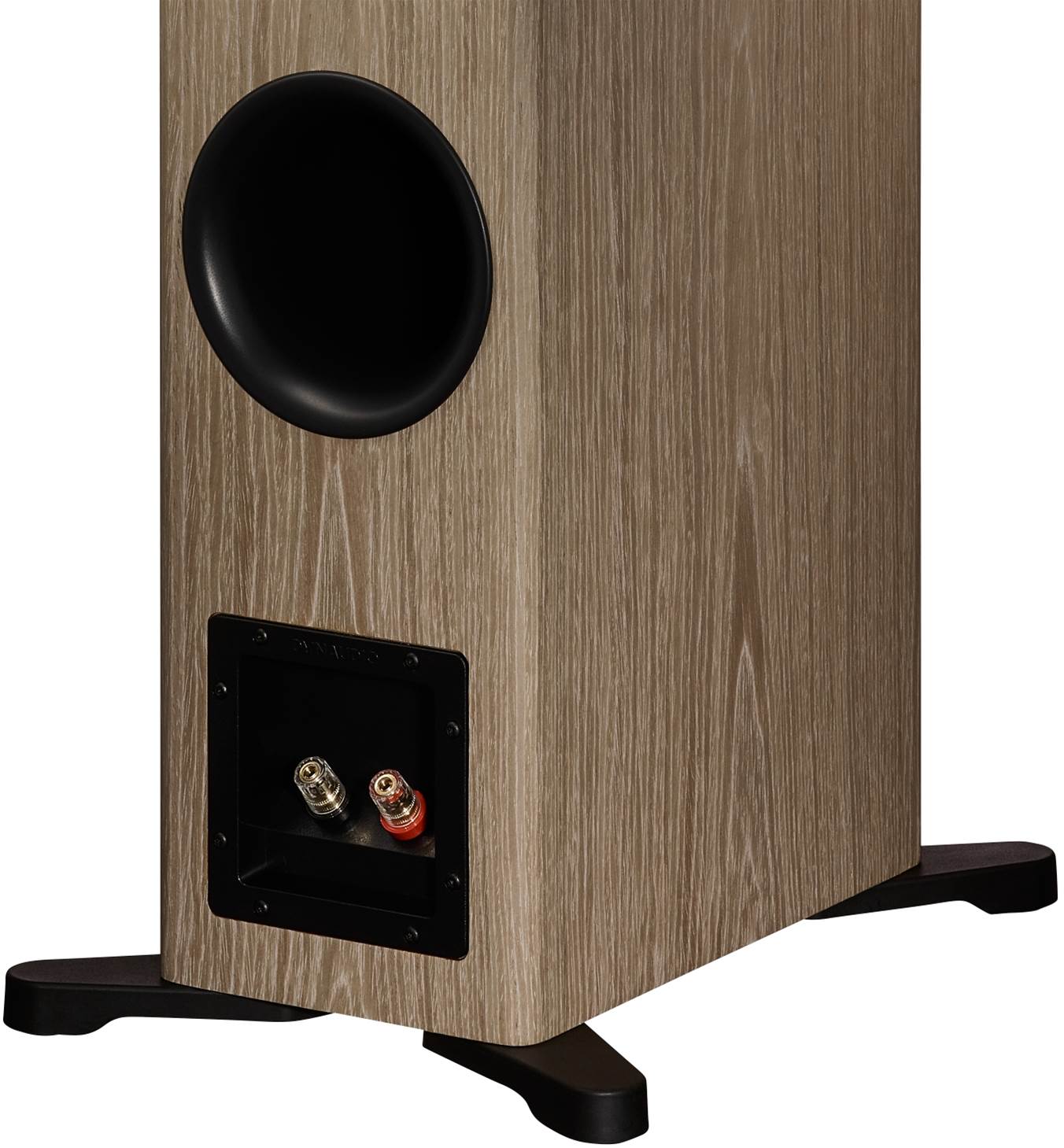
As is becoming increasingly common these days, Dynaudio provides soft foam plugs, or ‘bungs’ with the Evoke 50. The bungs provided with the Evoke 50 are in two pieces, with an inner plug and an outer ring. If you use both plugs, you effectively turn the speaker into a sealed enclosure. If you use just the outer ring, you simply reduce the size of the port. I’ll discuss how you’d use these bungs later in this review.
It’s very important to note that one thing all the drivers fitted to the Evoke 50 have in common is that they are all designed and manufactured ‘in-house’ by Dynaudio itself. This huge Danish company can now lay claim to having the largest and best-equipped anechoic speaker measurement chamber in the world, as well as one of the most advanced loudspeaker manufacturing factories in the world, both of which were the direct result of a huge injection of capital from Chinese manufacturer GoerTek, after it purchased Dynaudio in 2014.
This gives Dynaudio unprecedented control over the entire manufacturing process—there are very, very few loudspeaker manufacturers in the world that make all the drivers that are used in their speakers.
For the very few products used in its speakers that Dynaudio does not manufacture in-house, such as the capacitors and resistors used in its crossovers, for example, this Danish company is so large that it derives enormous benefits from the economies of scale. Whereas ‘bespoke’ loudspeaker manufacturers buy the essential bipolar capacitors and high-power resistors for their crossover networks from distributors at premium prices, Dynaudio buys its capacitors and resistors direct from the manufacturers. This way it not only gets better pricing—and a big say in quality control—but it can also have those capacitors and resistors branded ‘Dynaudio’ rather than with the name of the original manufacturer.
As I have already pointed out, the front baffle of the Dynaudio Evoke 50’s cabinet is only 215mm across, which is relatively narrow (which is not only cosmetically desirable, but has the advantage of improving dispersion from all the drivers) so you will be intrigued to hear that the rear of the cabinet is only 185mm across, meaning that the cabinet tapers in width from front to back so that the side walls are not parallel, a trick that inhibits the production of standing waves inside the cabinet.
The cabinet itself is quite tall—standing 1160mm high when its four outrigger feet are fixed underneath it. You will need these outrigger feet, too, because without them the cabinet is a little unstable and quite easy to tip over, because it’s so tall and narrow.
Even with the feet fitted the Dynaudio Evoke 50 isn’t exactly ‘rock solid’ stable, since it will overbalance if it is forcibly tipped more than 17 degrees to one side or the other.
The Dynaudio Evoke 50 is available in two different high-gloss painted finishes (high-gloss white and high-gloss black) and two different synthetic wood finishes: walnut and blonde.
Listening sessions
When you first unpack the Dynaudio Evoke 50 speakers, on the front of each cabinet you’ll find a bright yellow plastic puck right where the tweeter should be, attached via three tiny neodymium magnets. It could be that this ‘puck’ is there to protect the tweeters during shipping—and it certainly does this very effectively—but I suspect the real reason it’s there is to protect the tweeters from damage while the speakers are on display in retail showrooms. These days, there are fewer salespeople on showroom floors, and many customers (particularly children) feel the need to ‘poke’ drivers (particularly tweeters) when no-one’s looking, so with fewer salespeople to control out-of-control customers, it’s likely that increasing numbers of tweeters are being damaged.
In most cases it’s possible to completely repair a soft dome tweeter whose dome has been dented (the same is not true of hard-dome tweeters!) but in the particular case of the Dynaudio Evoke 50, its unique double-dome structure would make such a repair challenging, to say the least. More importantly, it would be difficult to see that the inner dome had been damaged by a customer in the first place. I guess that Dynaudio intends that the salespeople should leave the pucks in place whenever the speakers are not actually being demonstrated, and removed only for listening sessions.
Needless to say, all of the foregoing means that you need to remove the pucks… and indeed the words ‘Remove Before Use’ are moulded into the yellow plastic of the puck, but I dare say that if you have children—or grandchildren—you, too, may be able to put the pucks to good use, so don’t just discard them! And, just in case you were wondering, you can safely play music while the pucks are attached… just don’t expect to hear any high frequencies!
The foam port plugs do not come pre-installed, so if you want to use them, you’ll need to remove them from their protective zip-lock plastic bags and press them into the port tubes. When would you use them? Dynaudio has a fairly simplistic answer in its Owner’s Manual, which takes the form of this advice: ‘(Plugs) can be fitted to reduce the bass emphasis that may be apparent if the speakers are placed close to room boundaries. Some Dynaudio port plugs can be split to provide optional levels of bass volume reduction. For mild bass reduction, fit only the outer foam ring by sliding it in the port tube so that it sits just inside the flared port exit—making sure it retains its shape to minimise airflow turbulence. For more extreme bass reduction, fit the complete plug so that the port is blocked.’ I say this is simplistic because when you block the port completely you will certainly get a reduction in the level of upper bass, but you may find that you also get a slight lift in the level of the extremely low bass. Which is the more desirable outcome will depend not only on your room and where the speakers are positioned in that room, but also on the type of music you most often listen to.
Generally, I would recommend not using the plugs unless you find the bass a bit ‘boomy’ and ‘one-note’ in which case I’d recommend blocking the ports completely… not just using a ‘half bung’.
After years of experience of reviewing loudspeakers and being somewhat familiar with Dynaudio speakers in particular, I was expecting the stand-out feature of the Dynaudio Evoke 50s would be their midrange sound. This is because all three-way speakers have a huge advantage over all two-way designs, which is that the bass notes can’t ‘muddy’ the midrange, either through compression effects or more significantly, though Doppler distortion effects. ‘Doppler distortion?’ some may ask, ‘What’s that?’ And well may you ask!
You likely haven’t heard of it because all loudspeaker manufacturers prefer to keep very quiet about Doppler distortion because all of them sell speakers that suffer from it. You’re likely already familiar with the principle of Doppler distortion, which describes how the speed of an object affects its perceived pitch. If we are standing on a railroad station, and a train approaches us with its whistle blowing, we will hear the whistle as a higher frequency while the train is approaching, at its ‘proper’ (lower) frequency when the train is alongside us, and at an even-lower frequency when the train is moving away from us. This is because the train whistle’s sound waves are compressed when the train is approaching our listening position and ‘stretched out’ when it’s departing our position.
Now think about a bass/midrange driver that has to produce both bass and midrange sounds because the particular cabinet in which it’s fitted does not have a midrange driver. And let’s imagine that that driver is producing a deep bass note at 20 cycles per second (i.e., 20Hz), so it’s moving back and forth 20 times per second. At the same time, it’s also producing a midrange note at 1,000Hz, which means it’s also moving back and forth one thousand times per second at the same time that it’s moving back and forth 20 times per second. This means that instead of hearing a 1,000Hz tone, we will actually hear 1,020Hz as the cone moves towards us and 1,980Hz when it’s moving away. It’s only when the cone is midway through producing the 20Hz signal that we will hear the correct frequency of exactly 1,000Hz. That’s how Doppler distortion affects loudspeakers, and it is present in ALL two-way loudspeakers.
In all three-way designs, such as the Dynaudio Evoke 50, in the previous scenario the bass drivers will be producing the 20Hz tone, moving back and forth freely without having to deliver the 1,000Hz tone, and the midrange driver will be reproducing the 1,000Hz tone at exactly 1,000Hz, with no frequency variations at all. The advantage of a three-way loudspeaker design with its separate midrange driver should now be immediately obvious!

So, as I said before I digressed to make that very important point, I was fully expecting the midrange of the Dynaudio Evoke 50 to be the stand-out sonic feature of the design. But I was not prepared for the quality and expansiveness of the bass from the dual bass drivers, nor was I prepared for the performance from the new Cerotar tweeter, which was exceptionally good… so good that it was very easily encroaching on the Esotar3’s territory.
But back to that bass, it was so powerful that I half-checked the cabinets to see if they were rocking back and forth as a result of the driver excursion, but no… the cabinets were rock solid back and forth with no movement at all—no doubt thanks to those outrigger feet, which are far more effective at delivering front/back stability than they are delivering side/side stability. The bass is not only powerful (turn up the volume at the peril of your ears, and the annoyance of your neighbours… because those Dynaudio bass drivers are built tough, they can take it) but also enormously extended. The notes from the bottom-most keys of a grand piano are about the lowest-frequency sounds you’re ever going to run across in most music genres… classical, jazz, rock, et al, and after having used the Evoke 50s to enjoy the performances of a number of piano greats, from Wilhelm Kempff and Glenn Gould to Khatia Buniatishvili and from Art Tatum and Bud Powell to Keith Jarrett, and from Jerry Lee Lewis though Keith Emerson and Sir Elton John, I can tell you that the Dynaudio Evoke 50s deliver a fine rendition of a grand piano in full flight. The bottom-most notes are stringily tangible, and you’re never left wondering about pitch, even for the most briefly-struck keys.
The sonics are such that you can hear the soundboard at work making the sound bigger and more authoritative, and you’ll never be left wondering whether you’re listening to a Steinway or a Fazioli, such are the incredible detailing abilities of those Evoke 50 bass drivers.
As for that midrange, it was, as I have already intimated, absolutely superb: totally clean and clear, and not a hint of the boxiness that can affect two-way and 2.5-way speaker designs.
Obviously, this meant that vocal were particularly well-delivered, and for both male and female vocalists. I tend often to use ‘Sampler’ CDs when auditioning, because it saves a whole lot of disc-swapping, and on Ana Caram’s contribution to Chesky’s Jazz Sampler Volume 1 (Meditation) I heard the superb clarity of her vocal inflections as well as I think I ever have. The ability for a loudspeaker to mimic the spoken voice of someone you know well is a lot harder than you’d imagine, yet I’m happy to report that when one channel of a Dynaudio’s Evoke 50 was reproducing a mono home recording of the dulcet tones of my nearest and dearest, I could easily have sworn she was right there in the room with me. It didn’t fool the dog though… but then no loudspeaker ever has!
Of course midrange isn’t the sole domain of the human voice, and the midrange sound was also clearly superior when reproducing violin, guitar… essentially any instrument playing in the three octaves above middle C. Check any orchestral instrument frequency range chart and you’ll discover that there are a lot of them! If you’d like to hear something fabulous that has both the piano and the violin working the Dynaudio Evoke 50s’ midrange hard (as well as those superb bass drivers), I can totally recommend Brahms’ Complete Sonatas for Violin and Piano on Calliope (Harmonia Mundi) as performed by Andrew Hardy and Uriel Tsachor. The sonorities Hardy creates with his 1793 Guadagnini are ear-opening: the warmth of the instrument is exceptional, yet never so warm that you can’t hear the perfection of his vibrato. Unlike many such recordings, not only are the two musicians in perfect musical balance with each other, but the sounds of their two instruments are also perfectly balanced one against the other, something that’s enormously difficult to do with two instruments that produce their sounds so differently as the piano and the violin, due not only to the differences in acoustic size, but in the method of sound creation (i.e., vibration vs. percussion).
Returning again to that tweeter, and it encroaching on the Esotar3’s territory, I’ve always found Phil Smith’s posthorn solo in Bernstein’s take on Mahler’s Third, with the New York Philharmonic (DG 427 328-2), a very good test of a tweeter, and listening to it via the Dynaudio Evoke 50s I heard all of the brightness, cleanliness and punch-through that I expect to hear, and all against an atmosphere so orchestral you could cut it with a knife. The highest frequencies are beautifully extended, but not so extended that they become glassy, or bright. All in all it’s a beautifully balanced delivery of high-frequencies. No it’s not quite an Esotar3, I don’t think its extreme highs are quite as extended, but you’d have to be listening to extremely well-recorded high-res recordings to pick the difference… and even then you might not!
The ability of the Dynaudio Evoke 50s to create not only a superb stereo image, but a complete soundstage, is second to none… and you don’t have to be in the sweet spot either. In fact, you can try this for yourself when auditioning: sit exactly in the sweet spot, then move your head from side to side, and up and down, and twist it from side to side. If the speakers have been set up correctly, nothing will change: the performers will stay exactly in their positions and the soundstage will remain fixed in place, unaltered in width, height or depth (and you’ll hear plenty of each). That this is the case speaks volumes for not only the quality of Dynaudio’s drivers, but for the company’s quality control and testing procedures as well, because you can’t deliver this type of performance with ‘off the shelf’ drivers… they’re just not matched closely enough.
So far, so good, but is there a downside? Only one that I don’t think will affect anyone who’s looking at buying a pair of Dynaudio Evoke 50s, which is that to make the bass delivery truly lifelike and the midrange really sing, you’re going to need an amplifier that will happily drive low-impedance loads, preferably right down to 2Ω. Power output per se is not important—these are efficient loudspeakers, so they’ll make the most of any reasonably-powered amplifier—so any solid-state design that’s rated by its manufacturer with an output into a 2Ω load will be fine… or equally any non-SET valve amp with a 2Ω tap.
Verdict
Dynaudio’s new Evoke 50 loudspeakers sound ‘way bigger than they have any right to sound, given the relatively small size of the speaker enclosures, and that’s got to be great news for anyone with an average-sized room, or even a small room, who’s ever despaired about being able to buy speakers that would not dominate their décor.
But it’s not just that the Dynaudio Evoke 50s have a big sound… it’s that they sound fabulous, with super-extended, effortless bass, superb midrange and transparent highs, along with stereo imaging to die for. As you can tell, I loved the sound of these speakers, and I think you will too.
Labratory results
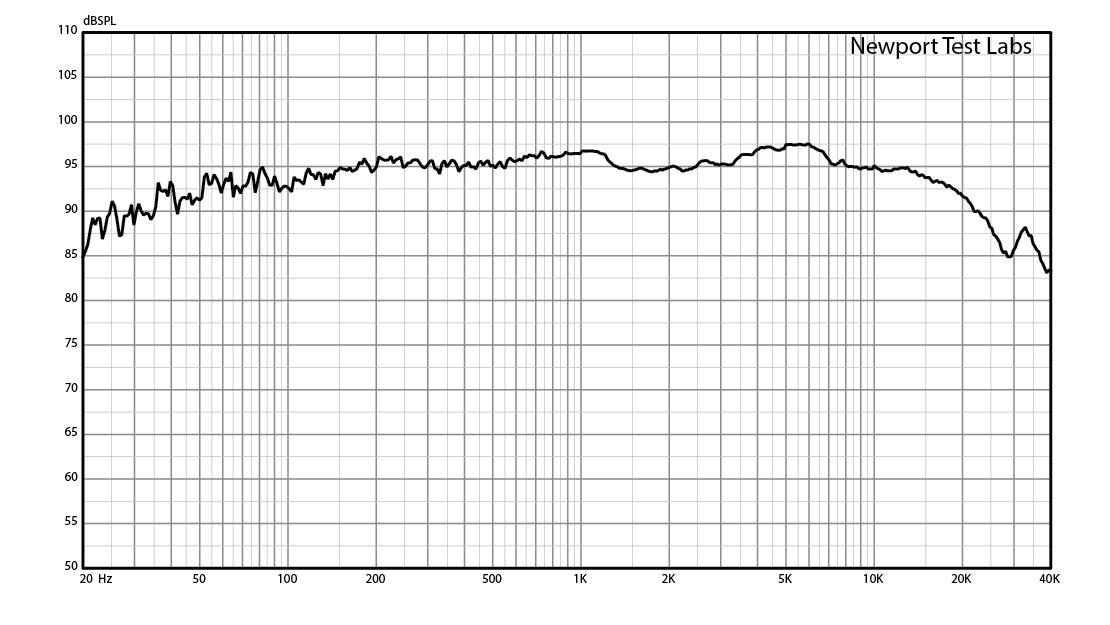
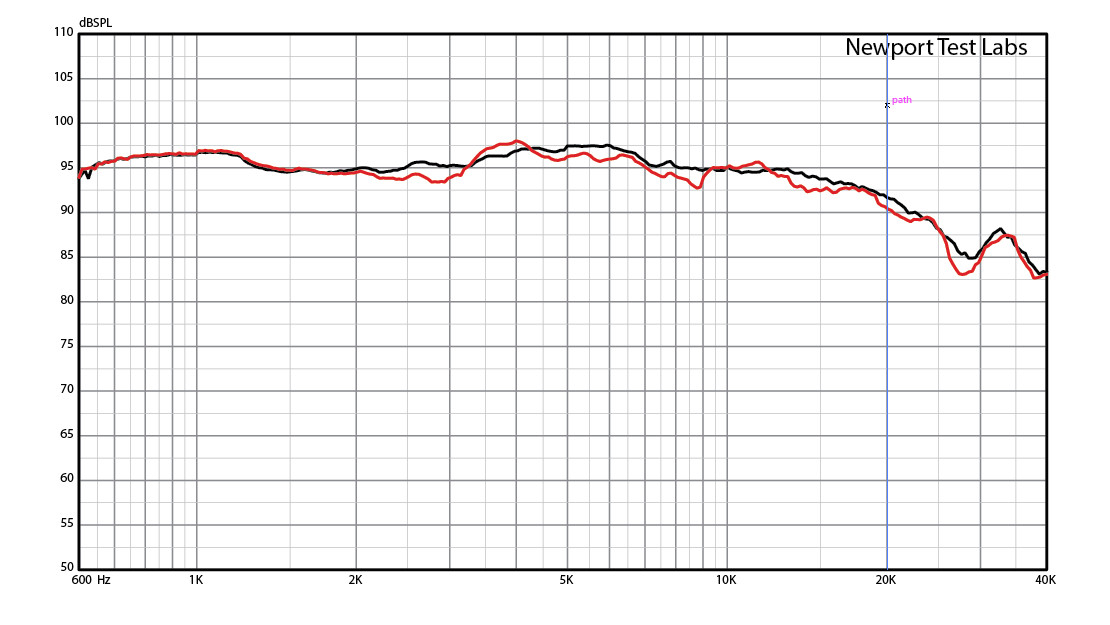
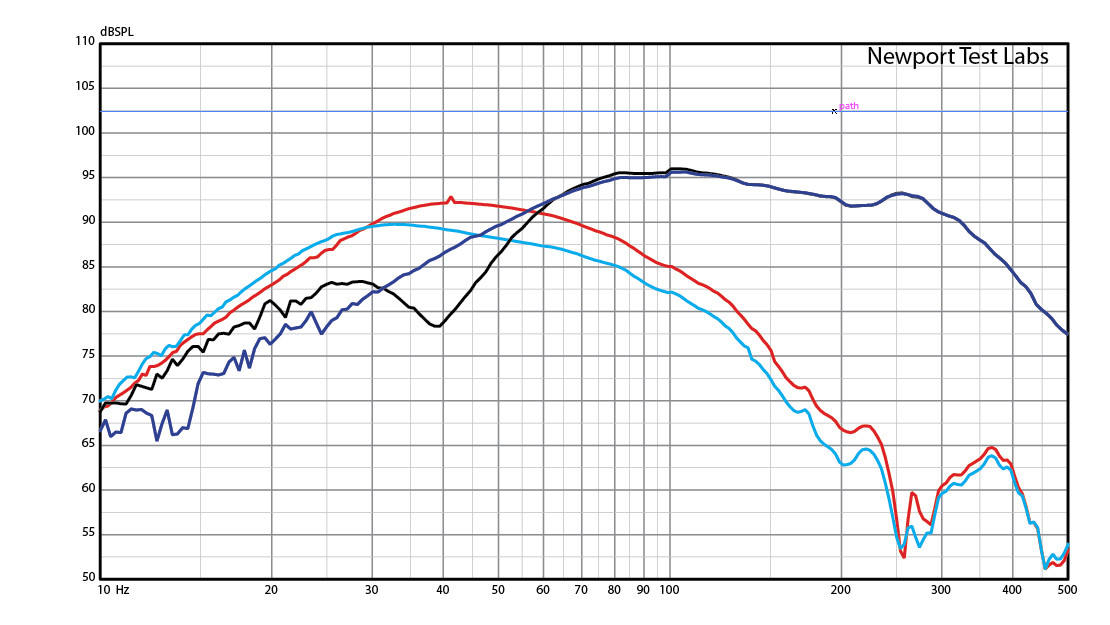
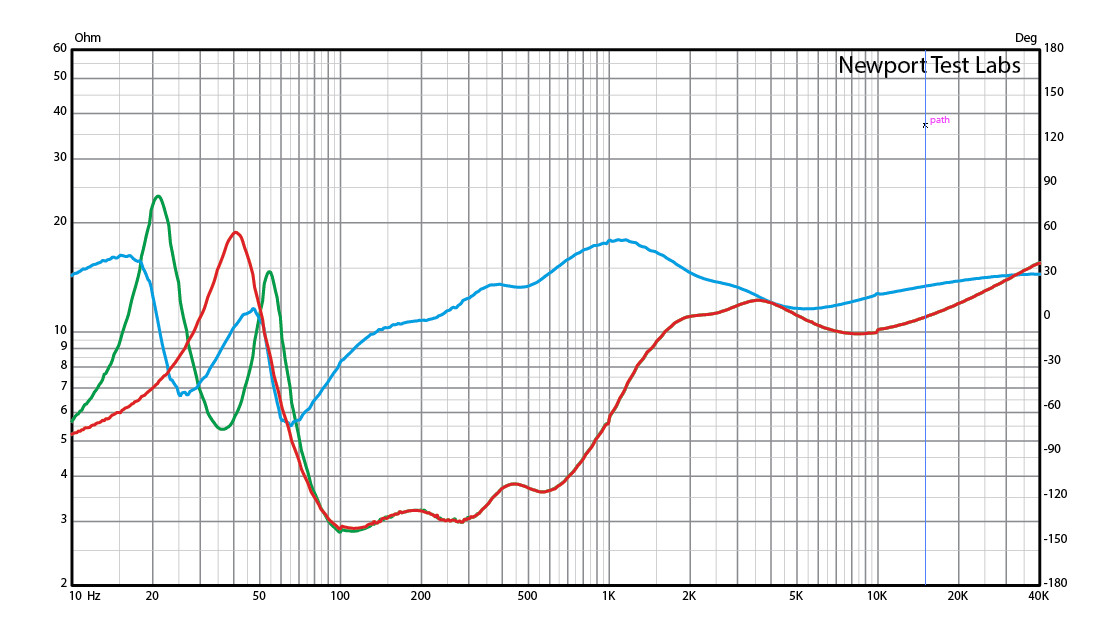
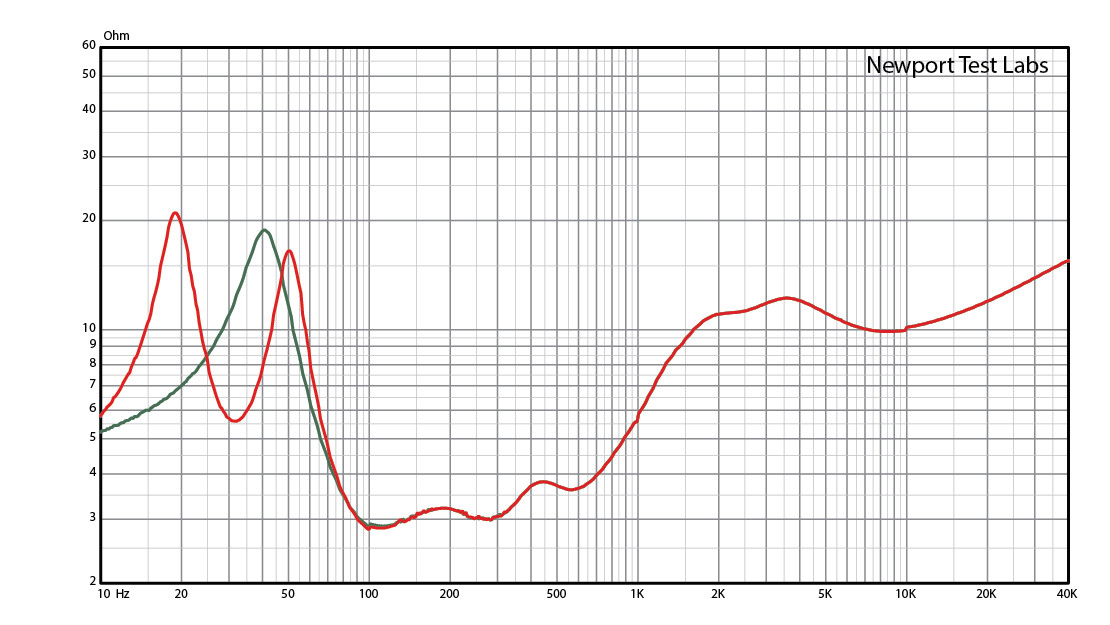

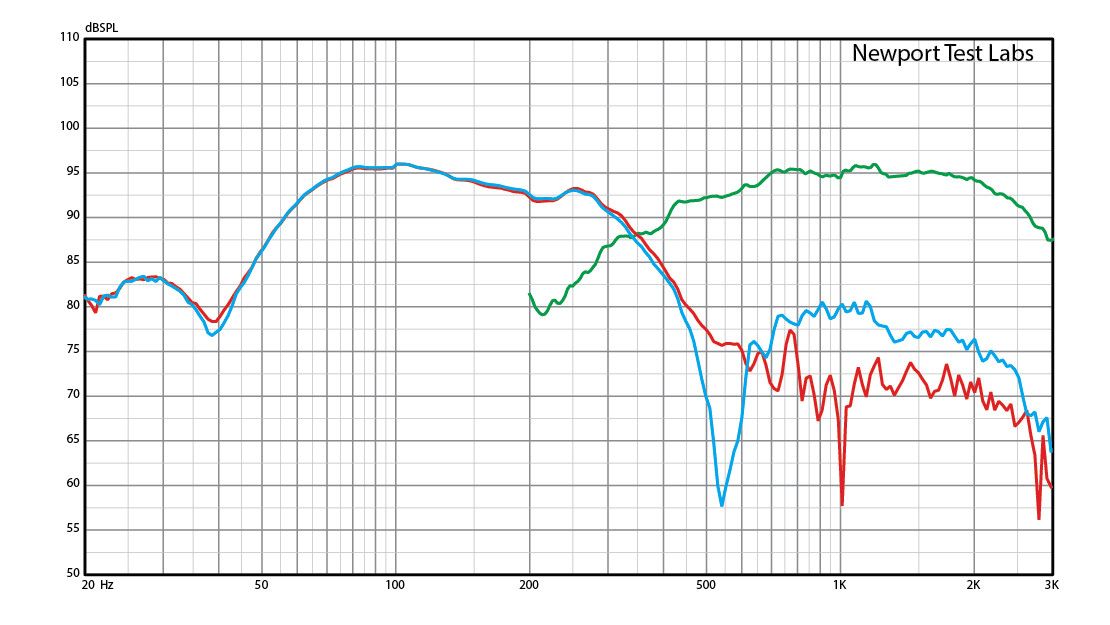

Newport Test Labs measured the Dynaudio Evoke 50 loudspeakers using its standard test procedures. Graph 1 shows a frequency response that was obtained using two different techniques. The section of the trace below 900Hz is the averaged result of nine individual frequency sweeps measured at a distance of three metres, with the central grid point of the microphone on-axis with the tweeter, so one measurement is made with the mic aimed directly at the tweeter, another with the mic higher, another with it lower, another with it off to one side, another with it off to the other, and so on, until nine traces have been acquired, after which they’re averaged via post-processing.
The section of the trace above 900Hz is the gated high-frequency response of the speaker, without the grille fitted. As you can see, each of the major horizontal divisions on the graph represents a 5dB change in level, so the graph shows the response of the Dynaudio Evoke 50 as extending from 35Hz to 22kHz ±3dB, which is an outstandingly good result, particularly in terms of bass extension, for a design that uses relatively small-diameter bass drivers and a relatively small-volume cabinet. Pedants with sharp eyes might point out that the trace is actually a little below the –3dB envelope between 42Hz and 52Hz, but the magnitude of the variation and the measurement variabilities at these frequencies mean that we can safely ignore this to arrive at the ‘overall’ response stated. So 35Hz to 22kHz ±3dB it is. That said, the response is not super-flat within these dB limits, with definite lifts to above the ‘reference’ SPL (85dB) at around 1kHz (only minor) and around 3–6kHz (also minor). Nonetheless I would thus expect the sound to have a very slight forward character at these frequencies.
Given that the higher of the two crossover frequencies is at 3.5kHz, I expect that the 3–6kHz lift is the result of some summing of the midrange and tweeter outputs, and as such might not be as apparent when listening slightly off-axis. The high-frequency response of the Dynaudio Evoke 50 is shown in greater detail in Graph 2, but you should note that the different measurement technique that’s used in order to provide this detail means that only high-frequencies can be measured (in this case, those above 900Hz). The graph shows the high-frequency response with the speaker grille off (black trace) and on (red trace). You can see for yourself that the response is marginally smoother and more linear without the grille, though the differences are barely significant. You can see that for this trace, taking 95dBSPL as the 0dB reference point, the response extends from 900Hz to 22kHz ±2.5dB.
The low-frequency response of the Dynaudio Evoke 50 that Newport Test Labs has shown in Graph 3 shows the output from the bass-reflex port without any bung at all (red trace) and with the half-bung fitted. You can see that without the bung, peak output is a bit above 40Hz, itself just a bit above the bass drivers’ minima at 38Hz. With the half-bung fitted, the output from the port drops by 5dB, as you’d expect, and the peak output also drops in frequency down to 32Hz. The black trace shows the response of one bass driver (for clarity) without any bungs, and you can see that the response rolls off quite steeply from around 60Hz. The blue trace shows one bass driver’s response when the port is fully blocked, resulting in a sealed (infinite baffle) enclosure and you can see that at 60Hz, instead of rolling off, the response extends linearly downwards at around 12dB/octave, as theory would predict.
Impedance vs. frequency is shown across three graphs, rather than just the usual single graph, due to the number of permutations permitted by the provision of, effectively, three completely different cabinet alignments, each one of which will affect the impedance (as you can see). There are several important take-aways from these graphs. The first is that the impedance of the Dynaudio Evoke 50 remains at or significantly below 4Ω from around 75Hz right up to 700Hz, so this speaker will require your amplifier to deliver some fairly serious current, as well as voltage. Secondly although Dynaudio specifies minimum impedance as being 3Ω at 100Hz, Newport Test Labs shows that minimum impedance of its test sample was a little lower again, at 2.8Ω (at 100Hz). Lastly, the impedance is fairly high at very low frequencies, and above 700Hz essentially continues to rise, so the Dynaudio Evoke 50 should be compatible with all modern Class-D amplifier designs, as well as conventional Class-AB designs.
Graph 7 shows the performance of both bass drivers and the midrange driver. You can see that although the bass drivers are identical, their different positions on the front baffle mean their performance is not identical. It’s almost the same up to 400Hz after which the response of the upper-most driver rolls off quite dramatically to trough at 550Hz before rising. I expect this is most likely a result of a standing wave inside the cabinet. It’s interesting, but at this frequency the midrange driver has well and truly taken over delivering the sound, as you can see from the green trace. This driver has a flat response, and its response rolls off nicely above and below its passband. Excellent design.
Newport Test Labs measured the sensitivity of the Dynaudio Evoke 50 as being 87dBSPL at one metre, for a 2.83Veq input under its standard test conditions, a result that is in exact agreement with Dynaudio’s own specification. Dynaudio’s Evoke 50 loudspeakers returned an excellent set of results in Newport Test Labs’ acoustic test laboratory, and is notable for having a particularly-well-extended bass response.
Australian Hi-Fi is one of What Hi-Fi?’s sister titles from Down Under and Australia’s longest-running and most successful hi-fi magazines, having been in continuous publication since 1969. Now edited by What Hi-Fi?'s Becky Roberts, every issue is packed with authoritative reviews of hi-fi equipment ranging from portables to state-of-the-art audiophile systems (and everything in between), information on new product launches, and ‘how-to’ articles to help you get the best quality sound for your home.
Click here for more information about Australian Hi-Fi, including links to buy individual digital editions and details on how best to subscribe.


